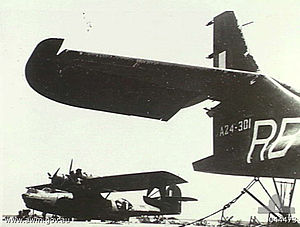- No. 42 Squadron RAAF
-
No. 42 Squadron RAAF 
A No. 42 Squadron Catalina (left) with a No. 20 Squadron Catalina (right)Active 1944–1945 Country  Australia
AustraliaBranch  Royal Australian Air Force
Royal Australian Air ForceRole Mine laying; maritime patrol Engagements World War II Insignia Squadron code RK Aircraft flown Patrol PBY Catalina No. 42 Squadron was a Royal Australian Air Force (RAAF) mine laying and maritime patrol squadron of World War II. It was formed in June 1944 and conducted patrol and mine-laying operations over the Netherlands East Indies (NEI) from August 1944 until the war ended a year later, as well as operations in the waters off southern China in early 1945. Following the Japanese surrender, the squadron performed transport and reconnaissance flights until it was disbanded in November 1945.
Contents
History
No. 42 Squadron was formed at Darwin in Australia's Northern Territory on 1 June 1944.[1] In early July the squadron's 50 personnel moved to Melville Bay aboard PBY Catalina flying boats and further personnel in August. The unit conducted its first operation on 27 August when three Catalinas flew patrols searching for shipping.[1]
During 1944 RAAF Catalinas based in northern Australia conducted a highly-successful minelaying campaign against Japanese shipping in the NEI which formed part of the North Western Area Campaign. In order to expand this campaign Air Vice Marshal William Bostock, the commander of RAAF Command, ordered that the Catalina-equipped No. 20, No. 42 and No. 43 Squadrons be assigned solely to minelaying under the command of No. 76 Wing.[2]
No. 42 Squadron commenced minelaying operations in September 1944. During this month it laid mines off Celebes and suffered its first loss on 23 September when a Catalina made a forced landing in Japanese-controlled territory; the aircraft's crew were later rescued by a No. 43 Squadron Catalina.[1] The squadron focused on laying mines off Makassar and Pare Pare Bay in Celebes during October, and lost two aircraft to Japanese anti-aircraft guns.[3][4] In November a detachment of aircraft was deployed to Morotai in the NEI, which had been captured by Allied forces in mid-September, from where they flew minelaying operations against Brunei Bay, Tarakan, Sandakan and the Balabac Straits.[3] Later in 1944 seven No. 42 Squadron Catalinas were deployed to Leyte in the Philippines from where they mined Manila Bay on the night of 14/15 December.[3]
In January and February 1945 No. 42 Squadron and the other units of No. 76 Wing focused on laying mines off Surabaya and the Laoet Straits.[3][5] One of the squadron's Catalinas was forced to make an emergency sea landing on 14 January after being damaged by Japanese anti-aircraft fire, but its crew was rescued by an aircraft from No. 43 Squadron.[3] From March to May detachments of No. 42 Squadron aircraft laid mines off the coast of southern China and Formossa as part of a No. 76 Wing offensive in this area; these operations were conducted from Jinamoc Island in Leyte Gulf with the aircraft refueling at Lingayen Gulf in Luzon while en-route to their targets.[3][6] During June No. 42 Squadron aircraft flying from Jinamoc Island via a refueling base which had been established at Brunei Bay laid mines off Sumatra while some of its other Catalinas mined Surabaya.[7] Following this, the squadron's aircraft were mainly used to conduct harassment raids on Japanese air bases in south-west Celebes, though they also attacked shipping in the Flores Sea and Banda Sea.[7]
No. 42 Squadron assisted in the repatriation of Australian prisoners of war from Manila and other Australian personnel from Labuan following the Japanese surrender.[7] The squadron also conducted several reconnaissance flights over Japanese-occupied islands. No. 42 Squadron was disbanded at Melville Bay on 30 November 1945.[8] During its existence it conducted 396 operational sorties, during which its aircraft dropped 549 tons of mines and 17 tons of bombs. The squadron also flew 6,330 hours of transport and courier flights. During these operations it lost very few aircraft.[7]
Notes
References
- Eather, Steve (1995). Flying Squadrons of the Australian Defence Force. Weston Creek: Aerospace Publications. ISBN 1875671153.
- Odgers, George (1968 (reprint)). Air War Against Japan 1943–1945. Australia in the War of 1939–1945. Series 3 – Air. Canberra: Australian War Memorial. http://www.awm.gov.au/histories/second_world_war/volume.asp?levelID=67913.
- RAAF Historical Section (1995). Units of the Royal Australian Air Force. A Concise History. Volume 4 Maritime and Transport Units. Canberra: Australian Government Publishing Service. ISBN 0644427965.
External links
- No. 42 Squadron. "Operations Record Book - Forms A50 and A51 Number 42 Squadron Jun 44 - Oct 45". Record Search. National Archives of Australia. http://recordsearch.naa.gov.au/scripts/Imagine.asp?B=1358858.
Main series 1 · 2 · 3 · 4 · 5 · 6 · 7 · 8 · 9 · 10 · 11 · 12 · 13 · 14 · 15 · 20 · 21 · 22 · 23 · 24 · 25 · 26 · 27 · 28 · 29 · 30 · 31 · 32 · 33 · 34 · 35 · 36 · 37 · 38 · 40 · 41 · 42 · 43 · 60 · 66 · 67 · 71 · 73 · 75 · 76 · 77 · 78 · 79 · 80 · 82 · 83 · 84 · 85 · 86 · 87 · 92 · 93 · 94 · 99 · 100 · 102 · 107 · 292 · Fighter · Rescue and Communication · Seaplane · Berlin Air Lift
Article XV squadrons Joint Netherlands-Australian squadrons Categories:- RAAF squadrons
- Military units and formations established in 1944
Wikimedia Foundation. 2010.
